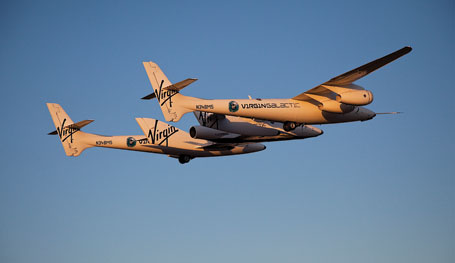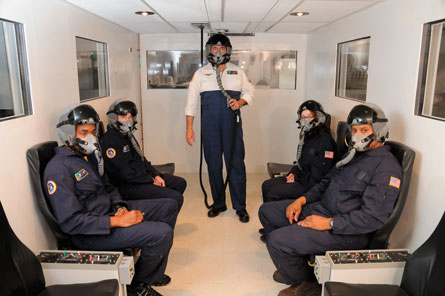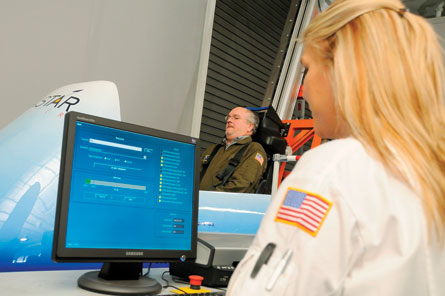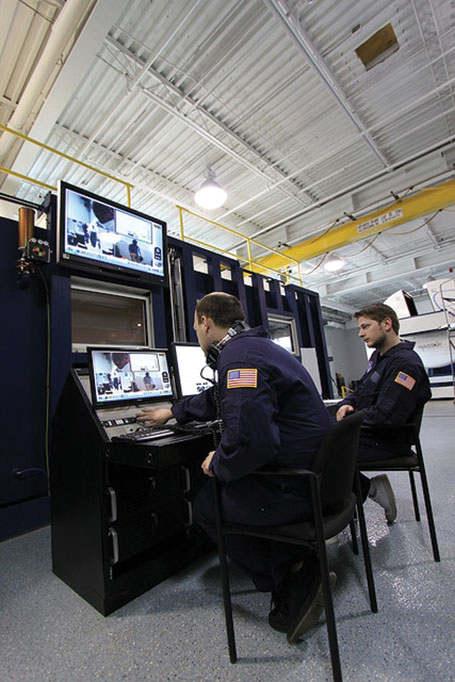Fifty years ago, cosmonaut Yuri Gagarin became the first human in space. Now the USA's National Aerospace Training and Research (NASTAR) Center is training what it calls the "pioneers of a new space age" - passengers for the first commercial spaceflights aboard Virgin Galactic's SpaceShipTwo.
Located at Environmental Tectonics in Southampton, Pennsylvania, the NASTAR Center runs a two-day suborbital spaceflight training programme priced at about $6,000. This includes six flights in the Phoenix Space Training Simulator STS-400, a dual-gimbal centrifuge that enables students to experience forces of up to 6g in two different axes. This technology was a leading factor in Virgin Galactic's decision to partner NASTAR.
"It's a very contemporary machine," says Virgin Galactic commercial director Stephen Attenborough.
 |
|---|
©Virgin GalacticVirgin Galactic needs data on how civilian passengers will cope with spaceflight |
Extreme forces
Virgin Galactic entered the partnership a few years ago to develop data that did not exist, says Attenborough: it is commonplace for professional astronauts and pilots to withstand extreme forces, but what about the average civilian? Virgin Galactic needed data on a host of physical and psychological factors.
The Phoenix is one of only two centrifuges of this type in the world and part of a sixth generation of simulators that originated in a 1992 design. It surpasses traditional g tolerance in centrifuges that allow for g forces in only one axis. At the end of a 7.6m (25ft), 12t arm, a dual-gimbal, two-axis system allows the Phoenix's gondola to face downward or upward, and turn outward or inward.
If the gondola did not have this capability and was fixed in place, riders would experience g force in the Y axis only (from shoulder to shoulder) as the centrifuge spun. However, by precise manipulations in the orientation of the gondola, a rider can experience gx (from chest to back) and gz (from head to toe) values.
A training maximum of about 6g mirrors the g load of the actual spaceflight, and at this level, the centrifuge reaches 26.4RPM while the capsule at its end moves at 75.8km/h (47.1mph). The gimbal system is driven by DC motors and cycloidal gear reducers. Backlash-free, the rollers and discs can handle very high torques relative to their size.
The gondola causes no oscillation in the centrifuge's arm, which deflects by only 0.0254mm (0.001in) when a rider boards it. Despite its space-age engineering, the Phoenix is constructed entirely of commercial off-the-shelf components, and doubles as the authentic tactical flight simulator when its inner module is swapped from a seat on SpaceShipTwo to the cockpit of a fighter jet.
Greg Kennedy, the NASTAR Center's director of education programmes, emphasises the importance of handling the mental and psychological stresses of spaceflight as well as the more obvious physiological factors. The physical demands may be the first thing on students' minds as they seek a Federal Aviation Administration-required third-class student pilot certificate before training - including checks of their weight, circulation, heart rate, breathing, blood pressure and medical history - to qualify for the 6g forces of the full training profile.
The first place Kennedy takes his students is not the centrifuge but an on-site altitude chamber, ostensibly to explain the dangers of hypoxia. On exit, they learn they have passed the first psychological test of their training: the ability to withstand confined spaces.
 |
|---|
©The NASTAR CenterTrainees learn manoeuvres that protect them at high g loads, and a whirwind course in the physics of flight |
Before their "flights", trainees attend classroom sessions to learn not only the physical manoeuvres that will protect them at high g loads, but a whirlwind course in the physics of flight, including the principles of gravity, speed, velocity, inertial force, and linear, radial and angular acceleration.
They also master the different axes of the body affected by g loads, depending on the stage of flight and position of the aircraft. Human anatomy and physiology are covered in lessons on the inner ear, the hydrostatic column between the heart and the brain, and visual disorientation. Information on general health, including the effects of nicotine and alcohol and the benefits of proper hydration, diet and exercise, are also on the agenda.
Trainees also learn the trajectory of their future spaceflight. They will ride to an altitude of 50,000ft (15,250m) attached to Virgin Galactic's White Knight II. Then SpaceShipTwo detaches and its rocket engine ignites. Almost immediately, passengers experience the only significant gz load of the flight (nearing 4g) as SpaceShipTwo makes its upward turn toward the edge of the atmosphere. For 3-4s, this force presses riders into their seats and brings the danger of g-induced loss of consciousness.
Once the craft comes out of its turn and is simply gaining altitude, the linear acceleration means a returning gx load of 3-4g. Crossing the boundary between our atmosphere and outer space at 328,000ft, the flight reaches its apogee at 360,000ft. For a few minutes, passengers experience the weightlessness of zero gravity and an eye-watering view of the Earth below (unable to simulate weightlessness, the STS idles through these moments).
Then re-entry begins, the spaceship's deceleration bringing a load of just over 6gx. All in all, the STS flight profile simulates only 6min in an overall flight of about 2h - but they are the most crucial moments on a flight that will reach almost 4,000km/h.
 |
|---|
©The NASTARCenterThere are both mental and physiological stresses for trainees to overcome |
Building tolerance
NASTAR Center trainees do not begin with full-flight simulation. Part of the course's value, says Kennedy, is that participants build g tolerance through successive exposures.
Students experience six different "flights" in three stages. First, they learn to handle the g force of two different axes separately, beginning with two gz experiences. The first ride takes them up to 3.5gz for 10s at 0.1g/s. A 20s rest at idle follows, and then another ride begins up to 3.5gz for 30s at 0.5g/s.
Helping to ensure Virgin Galactic riders can combat g-induced loss of consciousness caused by lack of oxygen to the brain, STS riders are taught the anti-g straining manoeuvre. This involves tensing the lower-body muscles and a "glottal hook", which is a sharp closing of the throat. When the strain and hook are held for a count of three in the correct rhythm, with breaths in between, the anti-g straining manoeuvre can increase g tolerance by up to 3.5g (versus the 1.5g gained through a g suit) by combating the drain of blood from the head and upper body at high g loads.
Trainees begin their second stage in the STS with two more flights, this time providing gx forces that comprise much more of actual flight conditions. Their third flight takes them to 4gx for 10s at 0.1g/s. A 60s rest follows before their return to 4gx for 20s at 0.5g/s.
The danger of high gx loads is the pressure on the lungs' alveoli, which provide the exchange of oxygen into pulmonary capillaries. A simple manoeuvre called positive pressure breathing keeps the alveoli inflated under high g forces. Maintaining a normal depth and rate of breathing, the rider exhales through pursed lips as if blowing through a straw.
Kennedy monitors all participants during flights, via verbal communication and a live video feed. Riders may experience a range of physical responses to the g force, including motion sickness, dizziness and headache. Distress symptoms during the ride can include blurred vision or loss of colour vision.
Trainees tackle the integrated flight profile on the programme's final day. The first stage-three flight covers the entire 6min simulation of release, launch, transition and re-entry at half speed. The sixth flight offers the full-power profile, including a 2s 6g peak at re-entry.
During this period of the actual flight, civilians are subjected to g force exceeding that of a NASA Space Shuttle launch, which tops out at 3gx and 1.5gz. The time-span of the STS g loads exceeds that of the real flight by several seconds. In this way, trainees build their tolerance beyond the expected minimum.
A surround-sound system's subwoofer places the engines' roar behind the rider, and a transducer beneath the seat creates the thrilling rumble of the engine and airframe. Simulated visual displays feature an altimeter, g meter, a computer-generated aft-camera view (relaying the rockets' flare at launch), the flight trajectory, and air speed in Mach and mph.
A computerised visual display approximates the view. Improvements under way include a wider field of view that will encompass peripheral vision, giving a better sense of the real flight's motion for space trainees.
But when will that actual flight happen? One Virgin Galactic agent estimates that SpaceShipTwo will carry its first customers (paying $200,000 per ticket) by late summer 2012.
The regulations and licensing of civilian spaceflight - and the machines that simulate it - are developing along with the industry itself. Any commercial spaceflight passengers must undertake the dangers with informed legal consent, including acknowledgement of the limited safety record of civilian spacecraft.
After their final flight up to 6g, NASTAR Center participants graduate from the programme with a certificate of completion - proof that they have what it takes for spaceflight.
 |
|---|
©The NASTAR centre"Pioneers of a new space age" at work |
Source: Flight International






















